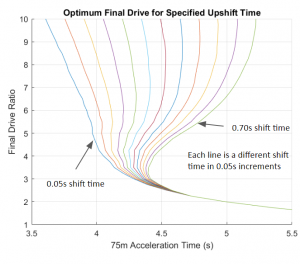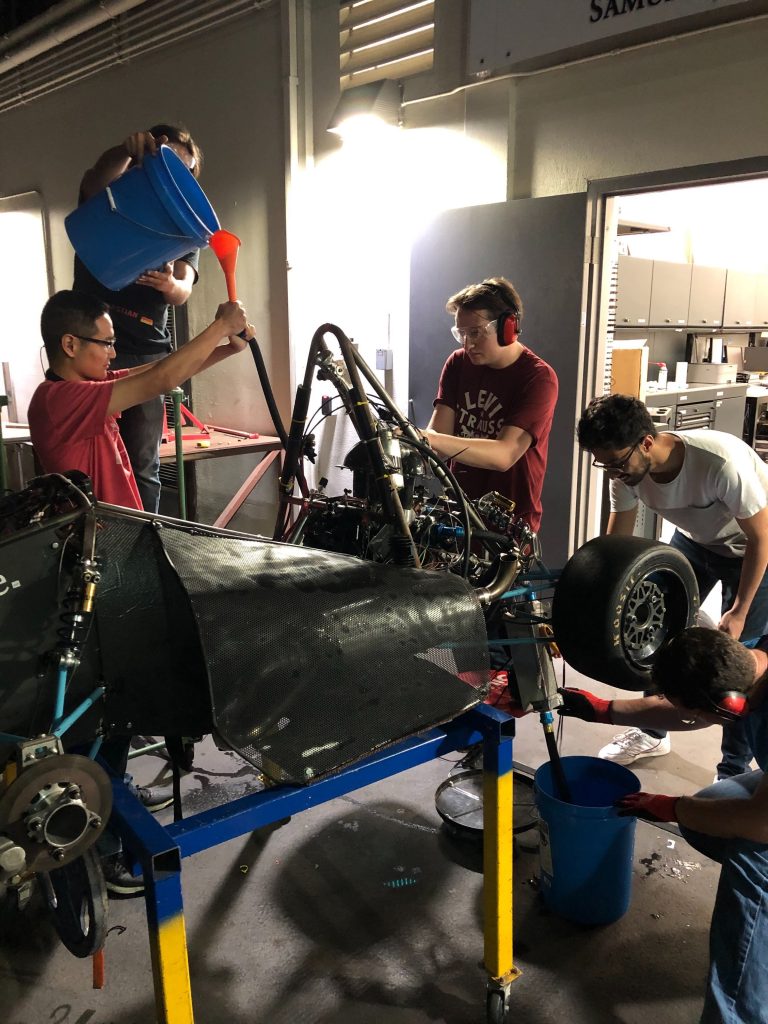by Matt McMurry
The Driveline Sub-system handles power delivery from the engine to the rear wheels and must design components that deliver power as quickly as possible. Acceleration performance is such a critical part of our competition that each decision can mean gaining or losing several places in the overall result.
There are many factors that influence a car’s maximum acceleration, but one of the main factors is the series of gear ratios in the transmission between the engine and the rear wheels. The transmission multiplies the engine output torque by the overall gear ratio and divides the engine rotational speed by the same amount. Increasing the overall gear ratio (by changing the primary, gear, or final drive ratios) will increase the amount of torque at the rear wheels, which will generally increase the acceleration of the car. For our team, it is too resource-intensive to change the primary or gear ratios, so we will change the final drive ratio (FDR) to meet our torque needs.
If a higher FDR will increase acceleration, why not just pick the highest ratio that will fit in the car? There are two reasons:
- The tires only have enough grip to transmit a certain amount of torque. If you exceed that torque value, you will begin to spin the tires, which prevents acceleration and makes the car difficult to drive.
- A higher FDR means the driver will have to shift gears more often. Shifting gears takes a finite amount of time (usually between 0.1 and 0.5 seconds), and the car does not accelerate during this period. This sounds like an insignificant amount of time, but 0.5 seconds of shifting is 12% of the entire Acceleration Event at competition.
Therefore a compromise must be made between shifting time, drivability, and final drive ratio in order to maximize acceleration.
To find the best compromise for our car we developed a discrete-time simulation of the car accelerating. The simulation takes into account things like drag and weight transfer and uses a tire model based on empirical data from the FSAE Tire Test Consortium as well as engine data from dynamometer testing. The shift time and FDR were varied and the Acceleration Event time was recorded for each combination. The results of the parameter sweep can be seen below:


A clear minimum acceleration time for a particular shift time can be seen in Figure 2. This minimum is increasingly obvious for longer shift times. The results are comparable to those found in similar research by Ping (1).
Previous testing has shown our average upshift time to be 0.25 seconds. For this shift time, the optimum FDR is 4.2. This will be the starting point for the car’s FDR. We plan to verify our simulations and fine tune the FDR through on-track testing.
This is the kind of advanced analysis that Anteater Formula Racing engineers do every day and is why UCI’s Formula SAE program is so important to our engineering education. We get to solve real engineering problems and follow them through the entire engineering process from analysis and design through to manufacturing and testing.
Matt McMurry is a Senior aerospace engineer and the Chief Engineer for Anteater Formula Racing. He is also the Lead Engineer for the Driveline sub-team, which includes Ryan Gagarin, Joseph Zhang and Patrick Hall.



